Mayan Glyphs on Georgia, Florida Pottery?
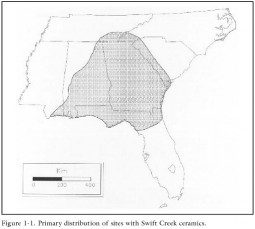
The arrival of corn at the Fort Center and Ortona sites in the Lake Okeechobee area of Florida by 200 AD coincides with a pottery tradition known as Swift Creek. In fact, this pottery tradition appears in the same places where the Hitchiti language was spoken thus the two are likely related. As noted in my article “Mayan Words Among Georgia’s Indians?” the Hitchiti language has several words of Mayan origin.
Researchers noted in A World Engraved: Archaeology of the Swift Creek Culture that many of the symbols found on Swift Creek pottery are similar to designs from Mexico. Although this similarity has been dismissed by mainstream scholars as coincidental26, in light of all the linguistic evidence it seems more likely that it is far from coincidental.
For instance, a plumed serpent-like figure has been found on a Swift Creek pot that is similar to feathered or plumed serpent designs from Mexico27. Due to its duck bill-like face it has been conjectured that it represents the wind aspect of the plumed serpent known by the Aztecs as Ehecatl-Quetzalcoatl. As noted by Susan Milbrath, “in the Codex Borgia, Ehecatl-Quetzalcoat is the patron of the day Wind, the counterpart of [the Mayan] Ik.”28 The plumed serpent in Mexico is also associated with Venus.
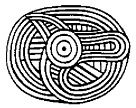 |
 |
|
Swift Creek “Coiled, crested serpent” |
Olmec plumed serpent |
Other Swift Creek designs known as “long-nose mask design,” and “unidentified creature” are similar to various versions of the Mayan ek glyph which means “star” or “Venus.”
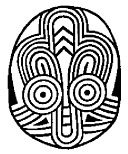 |
 |
| Swift Creek “Long-nose Mask” | Swift Creek “Unidentified creature” |
 |
 |
| Mayan EK glyph for “star” | Mayan EK glyph for “star” |
Although we do not know the meaning of the symbols on the Swift Creek pots we can deduce that they also have a relationship to stars since both designs feature two iterations of a symbol which consists of concentric circles with a central dot that has been shown to represent stars on petroglyphs in Georgia.30 The fact that this Swift Creek design features two such star symbols may represent Venus as the Morning and Evening star.
Another Swift Creek design known as “mask like design with unusual mouth element” appears to contain two versions of the Mayan lamat glyph both within a cartouche. The fact that the Swift Creek potters placed both symbols in a cartouche shows they believed these two symbols conveyed closely related or identical concepts. In Mayan, both of these symbols, the diamond and cross, are closely associated and used both separately and sometimes together to represent the Mayan word lamat, which is a symbol for Venus.
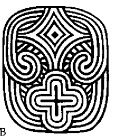 |
 |
 |
 |
| Swift Creek diamond-cross design |
Mayan LAMAT “Venus” glyph features both a cross and diamond |
Mayan LAMAT glyph featuring diamond design |
Mayan Venus/LAMAT glyph featuring rounded-cross design |
Interestingly, these designs predate the Maya. The earliest examples show up on Olmec pottery.31 When contained within a cartouche they stand for the day sign Lamat32 on the Mayan calendar and often associated with Venus, the morning and evening star.
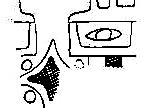
On the same Olmec pottery sherd can be found another glyph that looks like an eye and represents flint. The same symbol can be found on numerous Swift Creek pots. Throughout Mesoamerica flint was often portrayed with an eye or face.
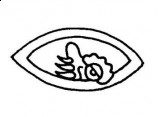 |
 |
 |
| Mesoamerican flint glyphs with various eye motifs | ||
 |
||
| Swift Creek flint/eye | ||
Flint in Mesoamerican cultures is associated with the sun. Coincidentally, the Spanish friar Juan de Cordova recorded a very interesting Mayan story that relates flint with sunlight and an all-seeing eye:
On the day we call Tecpatl ( Flint ) a great light came from the northeastern sky. It glowed for four days in the sky, then lowered itself to that rock (the rock can still be seen at Tenochtitlan de Valle in Oaxaca ). From the light there came a great, a very powerful being who stood on the very top of the rock and glowed like the sun in the sky.
There he stood for all to see, shining day and night. Then he spoke, his voice was like thunder, booming across the valley.
Our old men and women, the astronomers and astrologists, could understand him and he could understand them.
He (the Solar Beam) told us how to pray and fixed for us days of fast and feasting. He then balanced the “Book of days,” (Sacred Calendar) and left, vowing that he would always watch down on us, his beloved people.33
Thus the Swift Creek flint-eye is consistent with Mesoamerican beliefs. It should also be noted that Venus was also seen as a big eye in the sky. As Malbrath notes, “the double-headed serpent on Lintel 25 [at Yax-chilan] intertwines with a volute bearing a heavy-lidded eye framed by five radiating elements, a form of Venus symbol that may refer to Venus as the ‘big eye.’”34
The Mayan glyph for “sun” is known as kin. It looks like a flower with four petals sometimes with a dot in the center of each petal. Swift Creek pots appear to also represent this glyph.
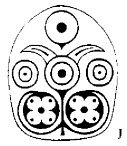 |
 |
 |
| Swift Creek ‘four-petal-w/-dots’ designs | Mayan ‘four-petal-with-dots’ kin glyph | Mayan ‘four-petal’ kin “sun” glyph |
The design also includes the quincunx, five dot, design which in Mayan has the phonetic value bi or be.35 Among the Maya it represented the five directions: north, south, east, west and center. Interestingly, the Hitchiti word bih means “head-chief” and the head chief was known as the Great Sun. Early eyewitness accounts of the Natchez, noted that each morning the Great Sun would smoke a pipe and blow the smoke towards the sun (center) and then to the four directions.36 Thus we see that among the Hitchiti-speakers, like the Maya, bih is associated with both the sun and five directions.
As Milbrath notes, “the Mayan quincunx glyph (T585a) may represent a variant of the central Mexican Venus sign. It has considerable antiquity, having been found on an Olmec scorpion sculpture (Monument 43) from San Lorenzo dated before 900 B.C.”37 and also had an association with Venus among the Maya. Interestingly, if the Swift Creek design is rotated 180 degrees it has a strong similarity to the Mayan/Aztec god Chac/Tlaloc who also is associated with Venus. (This will be discussed later.)
Another Swift Creek design known as “buzzard’s head” looks remarkably similar to the Mayan cimi glyph which is another calendar day sign and is associated with “death” and “reincarnation.” In fact, it is the thirteenth and final sign of the thirteen day period in the Maya Tzolkin calendar when the Trecena begins with jaguar.
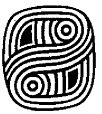 |
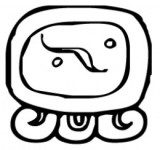 |
| Swift Creek “buzzard’s head” design | Mayan Cimi glyph for “death” & “transformation” |
The one difference is the Swift Creek design appears reversed from the Mayan design. This could be the result of the “stamping” process used to create the image. The Swift Creek designs were first carved into a wooden paddle and then pressed or stamped into the side of the pot while still wet. This process results in a reversed image thus the image carved on the paddle would have appeared similarly to the cimi glyph above.
Another Swift Creek design known as “unidentified creature” has been noted for its Olmec-style appearance38. It is very similar in design to the Olmec jaguar deity.
 |
 |
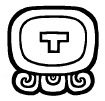 |
| Swift Creek Olmec-style “creature” | Olmec jaguar deity | Mayan Ik’ glyph for “wind/breath/spirit” |
The face of the Swift Creek jaguar appears to also contain the Mayan T-shaped ik’ glyph for “wind/breath/life.” To the Maya, the Jaguar’s spotted skin represented the stars of the Milky Way galaxy. The Maya also used a jaguar glyph with a quincunx symbol on its head to represent the planet Venus. (See chart below.) Thus this appears to be another possible representation of Venus on Swift Creek pottery. Jaguar is also one of the thirteen day signs of the Trecena and as just noted when the Trecena begins with jaguar it ends with cimi (death/transformation.) Thus the ik’ “breath/spirit” association with jaguar is an appropriate way to begin a cycle that ends with cimi “death/transformation.”
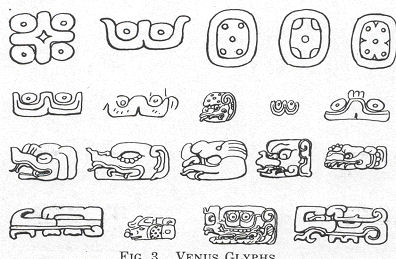
Another jaguar design appears on another Swift Creek pot but when turned upside down turns into the head of a rattlesnake. It also includes a flint knife in the center of the design:
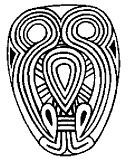 |
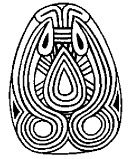 |
| Swift Creek “Jaguar” design w/ cleft head & flint knife nose | When rotated looks like a rattlesnake head |
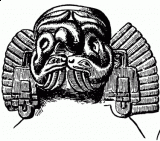 |
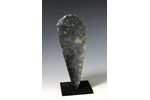 |
| Mesoamerican Tlaloc with snake eyes | Proto-Mayan flint knife |
Interestingly, this combination of a snake, jaguar with cleft head, and flint knife is consistent with Mesoamerican mythology. For instance, Matthew Stirling notes in his article “Early history of the Olmec problem,”
a “jaguar god who was…the forerunner of the important Aztec god Tezcatlipoca, [was] conceived of in one phase as a jaguar. ‘Thunderbolts’ or stone axes,‘rained from heaven,’ were attributed to his activities. Saville speculated that the cleft in the forehead characteristic of these jaguar axes was caused by the blow on the head received during his struggle with Quetzalcóatl, at which time he was transformed into a jaguar. One thing Saville did not mention is that the fetish or distinguishing mark of Tezcatlipoca is the flint knife, a feature shown on many of the were-jaguar votive axes.”39
The Swift Creek jaguar design includes a cleft-head and a flint knife nose and when rotated appears to be a rattlesnake head. Thus the Swift Creek design could have represented the struggle between Quetzalcoatl, the feathered rattlesnake, and Tezcatlipoca, represented as a jaguar.
A Swift Creek design mentioned earlier, when turned upside-down, also appears to be a representation of Tlaloc:
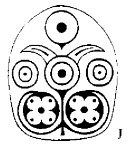 |
 |
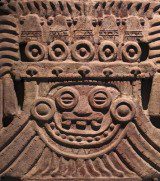 |
| Swift Creek ‘four-petal-w/-dots’ designs | Same design rotated looks like Tlaloc | Tlaloc w/ curved fangs and circled dots on cheeks |
Tlaloc was also a god of rain and thus fertility. Interestingly, the figure at left has the appearance of flowering plants but when rotated takes the appearance of Tlaloc which is consistent with these Mesoamerican associations.
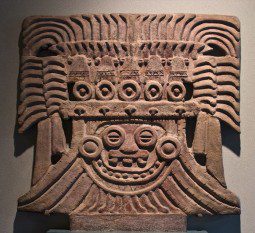 ?It should also be noted that Tlaloc is often represented in Mesoamerica wearing a headdress with circumpuncts in its headband. As noted previously, the circumpunct was likely a star symbol among the Hitchiti. The fact that Tlaloc had strong associations with Venus and wore a “crown” of circumpuncts suggests that the circumpunct was also a star symbol in Mesoamerica as well. (Interestingly, there are five circumpuncts in the headband at left. In Mesoamerica Venus was strongly associated with the numeral five which Milbrath refers to as the “fiveness of Venus” which she argued symbolized the “Venus Almanac of five Venus cycles correlating with eight solar years.”40 This further supports the argument that the circumpunct was a star symbol in Mesoamerica.)
?It should also be noted that Tlaloc is often represented in Mesoamerica wearing a headdress with circumpuncts in its headband. As noted previously, the circumpunct was likely a star symbol among the Hitchiti. The fact that Tlaloc had strong associations with Venus and wore a “crown” of circumpuncts suggests that the circumpunct was also a star symbol in Mesoamerica as well. (Interestingly, there are five circumpuncts in the headband at left. In Mesoamerica Venus was strongly associated with the numeral five which Milbrath refers to as the “fiveness of Venus” which she argued symbolized the “Venus Almanac of five Venus cycles correlating with eight solar years.”40 This further supports the argument that the circumpunct was a star symbol in Mesoamerica.)
The preceding myth about the battle between Quetzalcoatl and Tezcatlipoca includes symbolism which is suggestive of a meteor storm. For instance, stone axes raining from heaven could represent meteorites which fell to earth. Tlaloc has other associations which are consistent with this interpretation. For instance, he is said to fall from the sky and bury himself in the earth.
Among Native Americans, jaguars/panthers were also associated with meteors and shooting stars. For instance, the Shawnee leader Tecumseh’s name means “Shooting Star” or “Panther Across the Sky” and he received this name because of an especially bright and long-lasting greenish-white meteor that shot across the sky at his birth:41
As Pucksinwah stared at the sky on this night, he saw a huge meteor streak across from the north, leaving a trail of greenish-white flame. It lasted for fully 20 seconds and was unlike anything he had ever seen before. This was the Panther spirit that the old men sometimes spoke of, and a good sign indeed. As the women around the fire talked excitedly and pointed to the heavens, a baby’s cry came from the shelter. Usually a child was not named for several days while the parents waited for a sign to indicate what the great spirit Moneto wished the child to be called, but this child must surely be named Tecumseh, “The Panther Passing Across”
Shooting stars were viewed by many cultures, including Mesoamerican cultures, as the souls of the dead departing and/or returning to Earth.
Another Swift Creek design is similar in design to the xochitl “flower” glyph from Mexico:
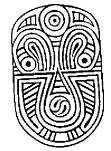 |
 |
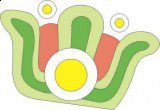 |
| Swift Creek design w/ ying-yang element | One version of xochitl “flower” glyph w/ yin-yang knot | Another xochitl glyph |
The xochitl flower glyph was the last day sign in the Aztec calendar and represented both the flowering of life and the disappearance from existence42. As noted above, the Mayan glyph for sun, kin, also was flower-shaped and likely represented similar concepts.
Another Swift Creek design is similar to another flower glyph from Mexico, the water lily glyph. This glyph was used to represent the number 13 which was a very important number among the Maya used to represent the concept of completion.43 The Maya included this glyph as a headdress on their Chac Serpent deity. (Chac was the Maya version of Tlaloc.) Thus we see the concepts of flowers, fertility, Tlaloc/Chac, stars/Venus, and completion are closely associated in Mesoamerica.
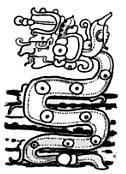 |
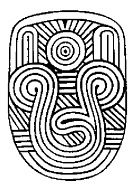 |
| “Chac serpent with waterlily headdress of Classic numeral thirteen head variant” | Swift Creek design similar to waterlily headdress |
The water lily also seems closely associated with stars. “The Lamat glyph sometimes represents a half star with a stylized water lily (Imix), resembling a variant of the star glyph known as T510e.”44
The water lily serpent is also associated with IK45, which in Mayan is associated with “wind, breath, life, spirit.”46 As noted by Milbrath, “in the Codex Borgia, Ehecatl-Quetzalcoat is the patron of the day Wind, the counterpart of Ik. This suggests that God H, the Water-Lily Serpent and Ehecatl-Quetzalcoatl are all related by an association with Venus and the wind.”47
Flowers were also associated with stars in the secret language of the Itza Maya priesthood known as the language of Zuyva. For instance, in the sacred book Chilam Balam of Chumayel, a section called “A Chapter of Questions and Answers” includes question #8 which is “large flower (of the night)” with the answer “star (in the sky).”48 (This secret language is believed to be related to Mixe-Zoque which happens to be the language of the Olmecs. Were the Itza priests actually Olmec?)49
Flint represented not only the sun and all-seeing-eye but also duality. The flint blade could bring life (via surgery or food preparation) or death (via the warriors knife.)50 Likewise the Cimi glyph was another calendar day sign with a meaning associated with death and reincarnation.
Interestingly, the Hitchiti word for “star” was owachiki which translates literally as “soul house.” Thus we see a clear connection between stars and the concept of death and reincarnation in both cultures.
In fact, the Swift Creek xochitl (“flower”) and ek (“star”) designs look strikingly like a female womb with fallopian tubes giving birth to a shining star! Indigenous cultures throughout Latin America refer to a woman’s vagina as her “flower” because many flowers, especially orchids, greatly resemble a woman’s sex organs. Thus the symbolism between flower and rebirth is clear. A woman’s womb, as the center of creation of new life, becomes an earthly “soul house” at birth in the same way that a star becomes a celestial “soul house” at death. Or put another way, the dead are reborn as stars.
 |
 |
| Swift Creek “xochitl” | Swift Creek “ek” |
 |
|
| Diagram of a woman’s reproductive organs showing similarity between Swift Creek “xochitl” and “ek” designs. | |
Considering the fact that most scholars believe the potters in Swift Creek culture were women, it seems highly appropriate that they chose to represent the story of life, death, and afterlife with the female anatomy.
Curiously Venus has a worldwide association with female sexuality:
“The planet was worshipped by all peoples and cultures of antiquity as the divinity of fertility, the goddess of war, beauty, and love. In its role as the goddess of war and fertility it is associated with the Morning star. In its role as the divinity of sexual love it is associated with the Evening star…In the West the planet Venus has always been linked to the female sex, women, in biology, botany, medicine, and other natural sciences.”51
It should also be noted that in Mesoamerican beliefs, Venus/Tlaloc/Jaguar were all associated with rain52 and thus fertility. The Maya goddess Ix Chel, depicted as an aged woman with jaguar ears, was a goddess of fertility and medicine. Ix Chel was one of the most revered gods among the Chontal Maya, also known as the Poton Maya. They were master seafarers and the most likely candidates who could have reached Florida and Georgia during this time period. (This will be further discussed in the conclusion.) Thus it is possible that these glyphs represent aspects of an Ix Chel fertility cult in the Southeast.
The association between Tlaloc/Chac, flint, fertility and rebirth can also be found in the Hero Twin myths. “In both Mesoamerican and some North American versions, ‘the second-born twin, representing the personified placenta or umbilical cord, sometimes has a flint association.’ Sometimes in Mesoamerica, the second-born hero twin is depicted as a flint or chipped-stone knife. In Post-Classic central Mexico, this human knife is shown as having anthropomorphic characteristics, including eyes and teeth. According to art historians Mary Miller and Karle Taube, ‘Chac and Tlaloc, respectively the Maya and Central Mexican hurlers of thunderbolts, were thus the creators of these valued materials.’”53
Interestingly, all of these glyphs have something in common: they all are related to astronomy, the sun, stars, life, death, and rebirth. In addition, many of these Swift Creek designs contain prominent concentric circles with a central dot. This symbol is used by cultures worldwide as a symbol for the sun and stars. It is known that Native Americans used this symbol for the sun as well.54
The fact that so many of these Swift Creek symbols are similar in design to Mesoamerican symbols whose meanings are constrained within a small range of possibilities is strong proof that they are likely Mesoamerican in origin. If the designs were based on random chance, you would expect to see designs more randomly distributed across the entire corpus of Mayan glyphs. The fact that these symbols show clustering around such a narrow range meanings provides strong evidence that something more than chance is responsible for the similarities.
Conclusion
As mentioned earlier, the Swift Creek pottery tradition began around the same time that corn agriculture first showed up in the Lake Okeechobee area of Florida. The Swift Creek pottery tradition also occurs in the same area where the Hitchiti tribe is known to have lived. It is also the Hitchiti language which features apparent loan words from Mayan. The Hitchiti migration legend appears to place them in the Lake Okeechobee area after having arrived on the Florida coast from a “place of reeds”:
“Their ancestors first appeared in the country by coming out of a canebrake or reed thicket near the sea coast. They sunned and dried their children during four days, then set out, arrived at a lake and stopped there. Some thought it was the sea, but it was a lake; they set out again, traveled up stream and settled there for a permanency”.55
At the time this legend was recorded, the Hitchiti lived in Georgia. Following this legend in reverse, the only place south or “down stream” from Georgia with a lake large enough to be confused with the sea is Lake Okeechobee. The fact they arrived at the sea coast suggests they arrived in Florida by boat.
More importantly, this legend states that the Hitchiti’s ancestors came out of a “reed thicket.” The actual Hitchiti word recorded in the legend is utski which translates literally as “reeds.” In the Mayan language, “reeds” or “place of reeds” is a metaphor for a large city. For instance, according to Mayan scholar Linda Schele in her book The Code of Kings, the Maya referred to the great Mesoamerican metropolis of Teotihuacan as Puh which means “reeds.”53 The great Toltec capital of Tula was also known as a “place of reeds.” “Place of Reeds” served as a metaphor relating the masses of reeds in a marsh to the masses of people in a metropolis thus a metropolis became a “place of reeds.”
The Hitchiti migration legend reference to their ancestors coming from “reeds” suggests they were Maya who left a major city in Mexico and then arrived on the coast of Florida and temporarily settled near Lake Okeechobee before heading upstream and settling in Georgia “for a permanency.” Interestingly, the Itza Maya referred to their ancestors as Ah Puh which translates as “Reed People.” Could the Hitchiti be descendants of the Itza Maya?
According to J. Eric Thompson in his book Maya History and Religion the Itza were a branch of the Poton Maya.57 He noted the Poton, who also called themselves the Yokot’an, lived in a province named Acala.
Interestingly, the first Spanish to visit Florida noted that a tribe named the Mayaimi lived around Lake Okeechobee. Other Spanish explorers with the Hernando de Soto expedition noted they visited a town in this area named Uqueten which was the southernmost village of a province named Ocale58, namesake of modern-day Ocala, Florida. They also noted that after leaving a town named Ocale they visited one named Potano59. Since Native American towns were named after the people who lived there it’s safe to assume people named Uqueten and Potano lived in a province named Ocale in Florida just like the Poton/Yokot’an Maya lived in a province named Acala in Mexico.

As previously noted the Poton Maya were master seafarers, often referred to as the Chontal Maya, and the most likely candidate to have made the voyage to south central Florida around 200 A.D. Based on a magnificent wooden sculpture known as the “Putun Maya Lord”60 which dates to around 500 A.D. we know they were expert wood carvers. Researchers have noted that the intricate Swift Creek designs carved into wooden paddles show they were also expert wood carvers.61
Also as previously noted, one of the primary deities worshipped by the Poton Maya was Ix Chel, a goddess of fertility and medicine. Their other primary deity was Kukulkan, the plumed serpent. Thus if Poton Maya traders had significant contacts with an area one would expect to find representations of these two deities. As discussed earlier, both a plumed serpent and fertility symbols have been found among Swift Creek pottery designs.
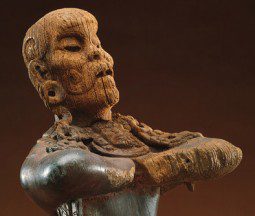
The Poton Maya (Chontal Maya) also claim to be descendants of the Olmec,62 the mother culture of Mesoamerica. The aforementioned “Poton Maya Lord” wooden statue has definite Olmec features. This may also explain the appearance of the Olmec-style jaguar glyph among Swift Creek designs.
The preponderance of the evidence seems to indicate that the Itza Maya were the ancestors of the Hitchiti tribe. They arrived in Florida around 200 AD as indicated by the arrival of corn in Florida, Mayan words in the Hitchiti language and Mayan glyphs on Swift Creek pottery. Massive earthen pyramids were also constructed at this time such as the Crystal River Mounds and Letchworth Mounds in Florida and Kolomoki Mounds in Georgia which is where much of this Swift Creek pottery has been found. The discovery of one of the largest sources of the mineral attapulgite just a few miles from these sites provides one possible reason for the Maya presence in the area. Attapulgite was used by the Maya to create the pigment Maya Blue which was very important to their culture. They were also likely mining gold in the north Georgia mountains. It seems highly unlikely that all these correlations are coincidental.
Work in progress. For more information visit: Maya in America- The Untold Story of Ancient America.
[References cited can be found on the original paper: “A Mayan Connection to Florida and Georgia Indians?“]


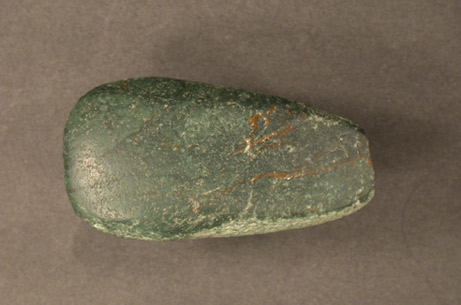

Pingback: Mayan Glyphs on… « Machimon
Pingback: Large cache of ancient Mayan pottery discovered in Georgia | SpittalStreet.com